So long Stumpy! D.C. spends $113M axing more than 130 cherry blossoms – including iconic stump-shaped tree – as with thousands of fans flock to say final farewell
A gnarled Washington DC cherry tree affectionately known as Stumpy is being torn down after becoming a social media phenomenon in recent years.
For visitors and cherry blossom enthusiasts, the annual tradition of walking the Tidal Basin among the flowers is a core Washington experience, and that includes Stumpy.
This year’s cherry blossom festivities in Washington will be the last for Stumpy and more than 100 other cherry trees that will be cut down as part of a multi-year restoration of their Tidal Basin home.
Stumpy became a social media star during the pandemic fever dream of 2020. His legacy has spawned an official mascot, T-shirtsa calendar and a fan base.
News of Stumpy’s last spring has prompted people to leave flowers And bourbon and had one Reddit user threaten to chain themselves up to the trunk to save the tree.
A gnarled old Washington DC cherry tree, affectionately called Stumpy, is being torn down after becoming a social media phenomenon in recent years
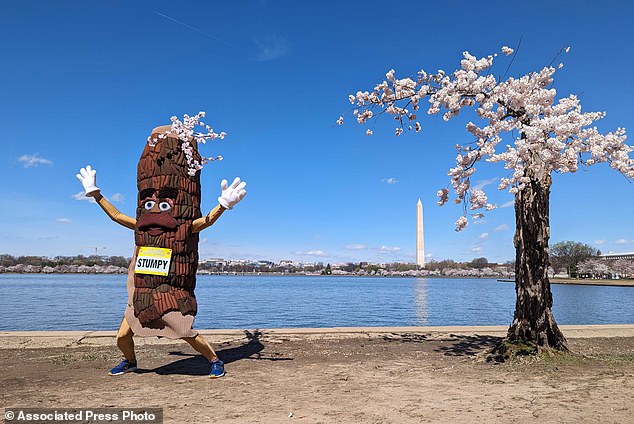
Stumpy became a social media star during the pandemic fever dream of 2020. His legacy has spawned an official mascot, T-shirts, a calendar and a fan base
The good news about Stumpy is that the National Arboretum plans to take parts of the tree’s genetic material and create clones, some of which will eventually be replanted in the Tidal Basin.
Jorge and Sandra Perez make it a point to come from Stafford, Virginia every year.
“Yes, we have cherry blossoms in my community, but it’s a completely different feeling when you see them all blooming together,” Sandra said. “And you can walk through the trees below and smell it. And it’s just a beautiful view.’
They also came looking for Stumpy, after hearing the legend and knowing that this would be the last spring.
“It’s actually beautiful,” Jorge said. “So it’s sad to see him go.”
Starting in early summer, crews will begin replacing the crumbling seawall around the Tidal Basin, the area around the Jefferson Memorial with the highest concentration of cherry trees.
The work is long overdue because deterioration, combined with rising sea levels, has caused Potomac waters to regularly flow over the barriers.
The twice-daily floods at high tide not only cover some of the footpaths, they also regularly soak the roots of the cherry trees.
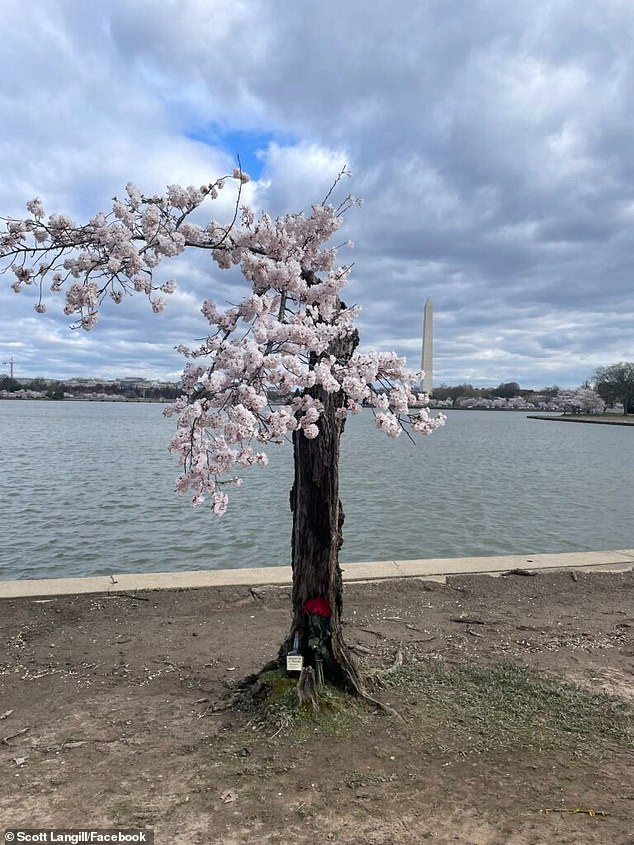
News of Stumpy’s final spring has prompted people to leave flowers and bourbon, and one Reddit user threatened to chain himself to the trunk to save the tree
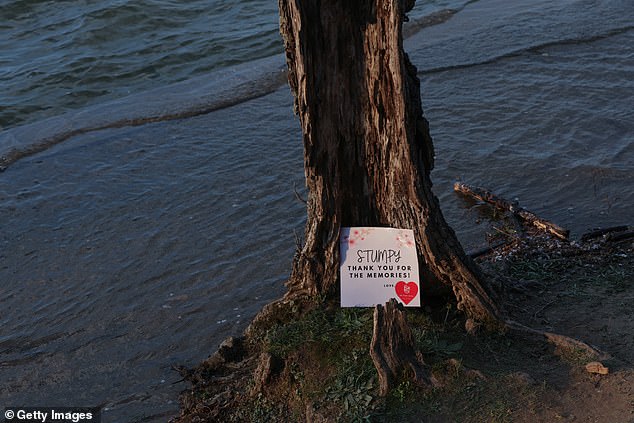
High tide reaches the base of a cherry tree nicknamed ‘Stumpy’ after a visitor left a thank you note in the tidal basin
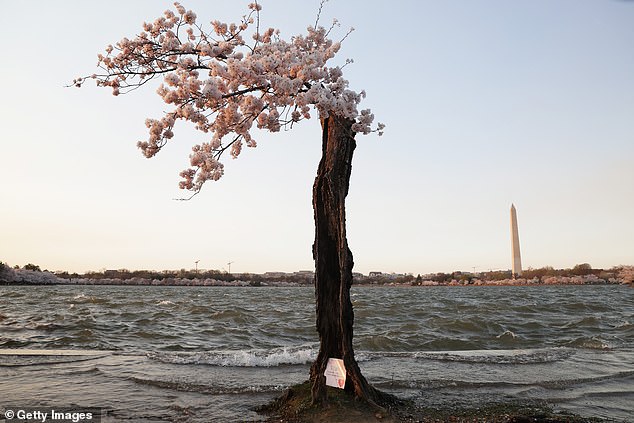
The good news about Stumpy is that the National Arboretum plans to take parts of the tree’s genetic material and create clones, some of which will eventually be replanted in the Tidal Basin.
The $133 million project to rebuild and strengthen the seawall will take about three years, said Mike Litterst, National Park Service spokesman for the National Mall.
“It certainly enhances the visitor experience, and that’s very important to us,” Litterst said.
‘But above all it will benefit the cherry trees, which now see their roots flooded with the brackish water of the tidal basin every day, twice a day.’
Litterst said entire swaths of trees down to the water, as wide as 300 feet, have been lost and cannot be replaced “until we solve the underlying cause of what killed them in the first place.”
The plans call for 140 cherry trees (and 300 trees in total) to be removed and turned into mulch. When the project is completed, 277 cherry trees will be planted as replacements.
The mulch will protect the surviving trees’ roots from foot traffic and break down into nutrient-rich soil over time, “so it’s a good second life” for the trees that are cut down, Litterst said.
The National Cherry Blossom Festival is widely regarded as the start of the tourist season in the country’s capital.
The organizers expect 1.5 million people to see the pink and white blossoms this year, the most since the coronavirus pandemic.
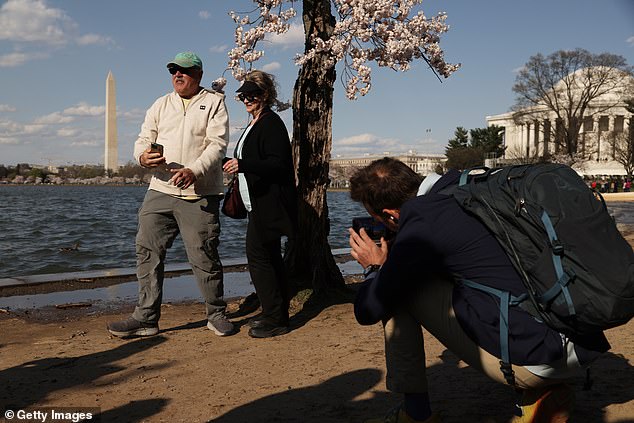
Visitors take photos of themselves with Stumpy before the tree is cut down
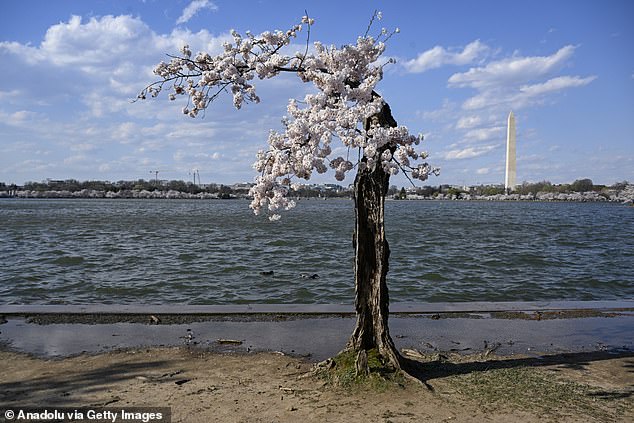
The National Park Service is preparing to remove nearly 150 cherry trees in an effort to repair the city’s deteriorating seawalls
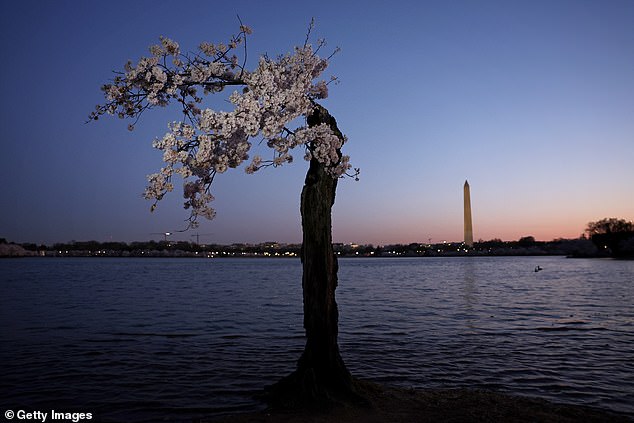
The cherry tree nicknamed ‘Stumpy’ stands in the high water of the tidal basin
Large numbers of cherry blossom fans have already flocked to the area as the trees reached peak bloom on March 17, several days earlier than expected.
Frequent flooding in the tidal basin – sea levels have risen about a foot since the seawall was built in the early 1990s – is just one of the ways climate change has affected the cherry trees.
Rising global temperatures and warmer winters have led to peak blooms rather crawl in the calendar.
This year’s peak bloom, when 70 percent of the city’s 3,700 cherry trees will be in bloom, was originally scheduled to begin around Saturday but was ultimately set for March 17.
For comparison, the 2013 peak bloom started on April 9.
Leslie Frattaroli, national resources program manager for the Park Service, told The Associated Press in February that peak blooms could regularly come in mid-March by 2050.
“All the timing is off.” he said. ‘It’s a huge cascade effect.’
Another side effect of the weather: a mid-March cold snap in the DC area should actually extend this year’s bloom past the predicted April 9 end.
